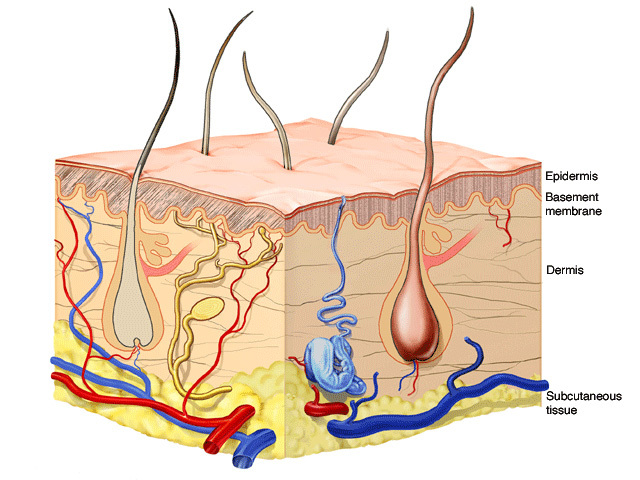Main menu
Common skin conditions

NEWS
Join DermNet PRO
Read more
Quick links
Created 2008.
The basement membrane zone is the communication channel between epidermis and dermis. The dermis supports the epidermis, providing nutrients and protecting it.
The dermis supports the epidermis by providing it with nutrients and toughness. It is made up of fibres and ground substance, with nerves, blood vessels and cellular infiltrations. The papillary dermis is the upper portion beneath the epidermis, characterised by thin haphazardly arranged collagen fibres, thin elastic fibres and ground substance. The lower portion is the reticular dermis, composed of coarse elastic fibres and thick collagen bundles parallel to the skin surface.
The dermis is full of double rows of peg-like formations called papillae under the basement membrane zone. Each double row underlies an epidermal ridge.
The papillary dermis is the portion of the dermis just below the epidermis. The reticular dermis extends from the papillary dermis to the fat.
Below this is subcutaneous tissue, the shock absorbing, and insulating and energy storage layer.
Structural components of skin Haematoxylin and eosin stained 

| Structure | Description |
|---|---|
| Basal cell membrane |
|
| Lamina lucida |
|
| Lamina densa |
|
| Sublamina densa |
|
| Structure | Description |
|---|---|
| Collagen |
|
| Elastic fibres |
|
| Ground substance |
|
| Fibroblasts |
|
| Blood vessels |
|
| Lymphatics |
|
| Nerves |
|
| Arrector pili muscles |
|
| Immune cells |
|
| Structure | Description |
|---|---|
| Adipose cells |
|
List collagen subtypes, their differences, location and function.
See the DermNet bookstore